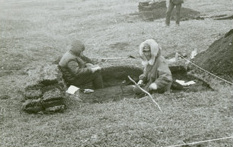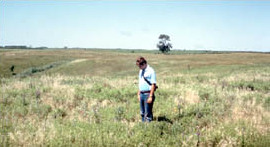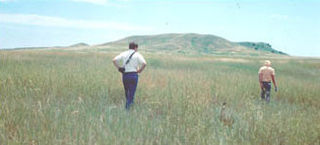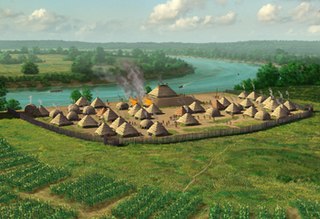Related Research Articles

The Portavant Mound is an archaeological site on Snead Island within the Emerson Point Preserve, just west of Palmetto, Florida. On December 23, 1994, it was added to the U.S. National Register of Historic Places.

The Birnirk site is an archaeological site near Utqiagvik, Alaska. It includes sixteen prehistoric mounds which have yielded evidence of very early Birnirk and Thule culture. It is the type site of the Birnirk culture, and was designated a National Historic Landmark in 1962 for its archaeological importance in understanding prehistoric Arctic cultures.

The Ipiutak site is a large archaeological site at Point Hope in northwest Alaska, United States. It is one of the most important discoveries in this area, competing only with Ekven, Russia.

The Iyatayet site is an archaeological site and National Historic Landmark located on the northwest shore of Cape Denbigh on Norton Bay in Nome Census Area, Alaska. It shows evidence of several separate cultures, dating back as far as 6000 B.C. It was excavated starting in 1948 by J. Louis Giddings, the pioneering archaeologist of the area. It is significant as the type site of the Norton culture, representative of human occupation c. 500BCE-500CE, first described by Giddings in 1964. It is also significant for the Denbigh Flint complex, which lay underneath the Norton materials, and provides evidence of some of the earliest human activity in the region. The site was declared a National Historic Landmark in 1961.

Yukon Island is an island in outer Kachemak Bay, an inlet of the Cook Inlet of south central Alaska. The island is located about 9 miles (14 km) south of Homer. The island is archaeologically sensitive, with a number of sites documenting the prehistory of the bay. The Yukon Island Main Site, a National Historic Landmark, is a major shell midden site at which the pioneering archaeologist Frederica de Laguna was able to sequence 1500 years of the area's prehistory, and other sites have been found on the island since then. The island is now home to an educational retreat center.

The Arzberger site, designated by archaeologists with the Smithsonian trinomial 39HU6, is a major archaeological site in Hughes County, near Pierre, South Dakota. It was declared a National Historic Landmark in 1964. It is a large fortified village, that is the type site for the Initial Coalescent, a culture that flourished in the area c. 1200-1350 CE.

The Bloom Site, designated by the Smithsonian trinomial 39HS1, is an archaeological site in Hanson County, South Dakota. It was declared a National Historic Landmark in 1964.

The Langdeau Site, designated by the Smithsonian trinomial 39LM209, is an archaeological site in Lyman County, South Dakota, near Lower Brule. It was declared a National Historic Landmark in 1964. The site was one of the first to provide evidence of horticultural activity by Native Americans in the region.
Landergin Mesa, near Vega, Texas, is an archeological site, preserving some of the most significant Texas Panhandle culture ruins. Landergin Mesa is a large site with many isolated structures, it is important because of the unique artifacts dating to the Antelope Creek Phase. There are well preserved examples of Borger Cordmarked ceramic vessels from the period. The site also exhibits unique architecture indicative of the Antelope Creek Phase.

The Wales Site, whose principal component is the Kurigitavik mound, is a well-documented archeological site on the Cape Prince of Wales, near Wales, Alaska. This site has artifacts from the Birnirk culture as well as the first discovery in Alaska of the later Thule culture. The site was designated a National Historic Landmark in 1962 for its archaeological significance.
Mero Mound Group or Diamond Bluff Site is an archeological site near Diamond Bluff, Wisconsin, in Pierce County, Wisconsin. It consists of at least two village sites surrounded by hundreds of mounds, including three effigy mounds. All were constructed from around 1000 AD to 1300 AD.
Palo Hincado Site, also known as BA-1, is an archeological site in or near Barranquitas, Puerto Rico. The site includes a plaza, a 33 metres (108 ft) by 15 metres (49 ft) ball court, and petroglyphs. Reportedly a number of petroglyphs on stones around the plaza and ball court) have been removed by collectors.

This portion of National Register of Historic Places listings in Puerto Rico covers the eastern region of Puerto Rico, from Carolina in the northeast to Arroyo in the southeast. It also includes the islands of Culebra and Vieques.

Frogmore Mound Site is an archaeological site of the Late Coles Creek culture in Concordia Parish, Louisiana. The site is located 7 miles (11 km) west of Ferriday on US 84. It was added to the National Register of Historic Places on July 28, 2004.

Deprato Mounds, also known as the Ferriday Mounds, is a multi-mound archaeological site located in Concordia Parish, Louisiana. The site shows occupation from the Troyville period to the Middle Coles Creek period. The largest mound at the site has been dated by radiocarbon analysis and decorated pottery to about 600 CE.
The Mahlac Pictograph Cave is a rock art site on the island of Guam. It is located high in the southern mountains of the island, and contains more than 40 images, rendered in paints that are white, red, brown, and black. The art was carefully analyzed in 2011, and a radiocarbon date of c. 600 CE was obtained from a paint sample. The meaning of the art is a subject of debate.
The Fouha Bay Site is a prehistoric archaeological site near the village of Umatac on the southwestern coast of Guam. First identified in 1977 during a systematic survey by archaeologist Fred Reinman, the site was radiocarbon dated to CE 1200–1400. However, differences in the rate of deposition along stream and river banks make these dates uncertain. Because of a proportionally larger number of archaeological sites in the geologically different parts of eastern Guam, this site is significant in understanding how deposition rates affect site dating methods.
The St. Croix River Access Site is a prehistoric Native American archaeological site on the St. Croix River in Stillwater Township, Minnesota, United States. It consists of a habitation site with a large quantity of stone tool artifacts, occupied from roughly 800 to 1700 CE. It was listed on the National Register of Historic Places in 1984 for having local significance in the theme of archaeology. It was nominated for its scientific potential to illuminate Late Woodland period cultural relationships, lithic technology, and resource use.

The Annis Mound and Village site is a prehistoric Middle Mississippian culture archaeological site located on the bank of the Green River in Butler County, Kentucky, several miles northwest of Morgantown in the Big Bend region. It was occupied from about 800 CE to about 1300 CE.
Punta Ostiones Site, also known as Ostiones CR-06, is an archaeological site located in or near Punta Ostiones, in the southwestern Puerto Rican municipality of Cabo Rojo, Puerto Rico. Ostiones CR-06 was added to the United States National Register of Historic Places on August 25, 2004, due to being one of the type sites of the Ostionoid culture, a Pre-Columbian archaeological culture represented by the Taino people during its latter stages.
References
- ↑ Federal and state laws and practices restrict general public access to information regarding the specific location of this resource. In some cases, this is to protect archaeological sites from vandalism, while in other cases it is restricted at the request of the owner. See: Knoerl, John; Miller, Diane; Shrimpton, Rebecca H. (1990), Guidelines for Restricting Information about Historic and Prehistoric Resources, National Register Bulletin, National Park Service, U.S. Department of the Interior, OCLC 20706997 .
- ↑ Cinquino Tronolone; Tronolone, Michael A.; Carmine A. (19 October 1984). "Algodones 2 (12VPr2-204) NATIONAL REGISTER OF HISTORIC PLACES INVENTORY - NOMINATION FORM" (PDF).
{{cite web}}: CS1 maint: multiple names: authors list (link)

